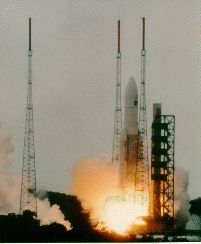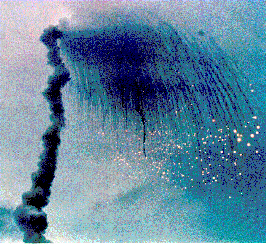
|
The Aborted Launch of Cluster I
|
 |
http://www.mps.mpg.de/en/projekte/cluster/aborted_launch.html
The Aborted Launch of Cluster I


(Both photos:
A. Nogues/SYGMA for ESA/CNES)
Back to  Cluster page.
Cluster page.
Cluster I was launched on June 4, 1996, on the first qualification
flight of Ariane 5. The rocket performed nominally up to about
37 seconds, at which point it veered off course, was ripped apart, and
exploded, at a height of about 4 km. Some of the Cluster satellites
and their instruments were recovered from the nearby swamps, totally destroyed.
The
 Report
by the Inquiry Board finds that a programming error in the navigation
software, which was inherited from Ariane 4, caused the steering
program to crash: mere test data were subsequently sent to the steering
jets. The subprogram where the error occurred was only meaningful
before
lift-off, but was allowed to run an additional 40 secs.
Report
by the Inquiry Board finds that a programming error in the navigation
software, which was inherited from Ariane 4, caused the steering
program to crash: mere test data were subsequently sent to the steering
jets. The subprogram where the error occurred was only meaningful
before
lift-off, but was allowed to run an additional 40 secs.
 retrieving parts
retrieving parts.
Recovery of the Cluster Mission
The Proposed Phoenix Mission
For each of the 11 experiments on board
Cluster, 5 units had been
built: four to fly on the 4 spacecraft, and one reserve unit.
As a first and immediate attempt to recover the mission, a fifth spacecraft
was quickly assembled with the reserve units. Named the
Phoenix
Mission, it was not intended as a replacement for
Cluster but rather
only as a stop-gap.
Cluster II
The real recovery program required more time to be set in motion, since
it would cost more and involve intensive commitments from the participating
institutions. Negotiations were finally completed at the end of 1996.
Cluster II was to be built, as much as possible, as an exact copy of the original lost
Cluster
I, in order to avoid development and testing expenditures (both in
time and money). The Phoenix spacecraft, which was already being
assembled from the old flight spaces, was then complemented by 3 additional
spacecraft to make up the fleet of 4 once again. Because of procurement
and staff problems (old parts no longer available, people retired) an exact
duplicate of the original is not 100% realizable; however, the differences
were kept to a minimum.
Cluster II was launched in the summer of 2000 on two Soyuz
spacecraft from the Baikanur Cosmodrome.
See  launch news.
launch news.
Back to  Cluster page.
Cluster page.






![]() Cluster page.
Cluster page.
![]() Report
by the Inquiry Board finds that a programming error in the navigation
software, which was inherited from
Report
by the Inquiry Board finds that a programming error in the navigation
software, which was inherited from ![]() launch news.
launch news.
![]() Cluster page.
Cluster page.